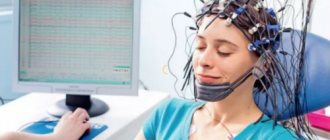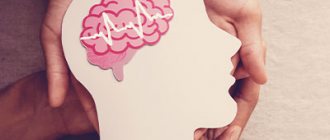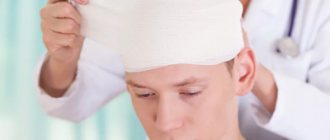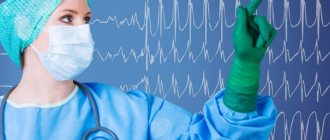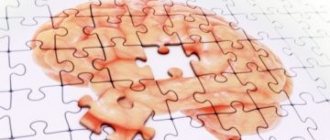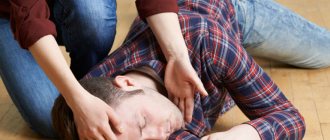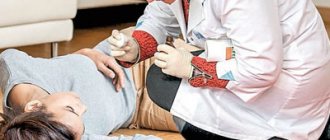Surely many, upon hearing the word “epilepsy,” will say that this is a mental illness and should be treated by a psychiatrist. This is fundamentally wrong. If you suspect epilepsy, you need to see a neurologist, since epileptology, the science that studies epilepsy, is a branch of neurology.
A child with epilepsy can be observed by a psychiatrist if he has mental disorders caused by epilepsy itself or concomitant pathologies. But epilepsy itself is treated by a neurologist.
What examination helps identify epilepsy?
Epilepsy is a chronic disease in which foci of excessive excitation appear in the brain. It can occur at any age. According to the World Health Organization, about 50,000,000 people worldwide suffer from epilepsy. The proportion of the population with active epilepsy (and therefore in need of treatment) in 2021 ranges from 4 to 10 per 1000 people.
The only method for reliably detecting epilepsy is an EEG - a recording of the electrical activity of the brain, which makes it possible to detect these foci.
Additional methods - MRI, computed tomography, genetic studies help to carry out differential diagnosis, for example, to identify the site of hemorrhage or tumor, the presence of hereditary pathology.
A typical EEG session lasts 20-30 minutes and quite often does not reveal any signs of disease in a child or adult, even if there were suspicious symptoms.
Therefore, if there is a suspicion of epilepsy, video EEG monitoring of sleep and a long period of wakefulness is carried out with functional tests (synonyms are video EEG monitoring of night sleep, video EEG monitoring of daytime sleep, video EEG monitoring of night sleep, video EEG monitoring of 24 hours, and so on), which allow you to provoke an attack. Parents are often worried when they hear that the doctor will try to cause an attack, however, sometimes this is the only way to make a completely reliable diagnosis.
Parents should be aware that most children whose EEG shows epileptiform activity do not have epilepsy . They are at risk, but often do not suffer a single attack in their entire lives and do not need any treatment. Moreover, 10% of people have experienced a convulsive episode at least once in their lives, but they are not diagnosed with epilepsy, since one of the main criteria for making such a diagnosis is the regularity of attacks.
Manifestations of epilepsy are not:
- Sleepwalking (sleepwalking). Sleepwalking in itself is not a manifestation of epilepsy. If any other symptoms are present, they must be considered together.
- Headache. Headache is a syndrome that can indicate the presence of a variety of diseases and must also be considered in conjunction with other symptoms.
- Hyperkinesis, tics. Hyperkinesis is a violent stereotypical movement; in children it can be a manifestation of a whole group of diseases and is not always an indication for an EEG.
- Bedwetting (enuresis). It occurs both in children with epilepsy and in those who do not suffer from it.
Causes of epilepsy
The diagnosis of epilepsy is associated with serious deviations in the electrical activity of the nerve cells that form this discharge. If this discharge leaves the limits of its focus, then a partial attack occurs; in the case of the spread of abnormal activity in all parts of the central nervous system, a generalized disorder develops.
Epileptic seizures and their causes in adults are associated with an acquired type of pathology, which appeared as a result of exposure to a large number of unfavorable factors. These include:
- tumor-like neoplasms;
- suffered a stroke;
- traumatic brain injuries;
- multiple sclerosis;
- vascular disorders;
- infectious diseases of the brain (encephalitis, meningitis, abscess);
- influence of medications;
- drug abuse;
- alcoholism.
If one of the parents has a history of pathology, then there is a high probability of its occurrence in the child.
Expert opinion
Author: Polina Yuryevna Vakhromeeva
Neurologist
According to world statistics, epilepsy is one of the most common and dangerous diseases. The proportion of the general population suffering from the disease is 4-10 per 1000 people. Doctors note an annual increase in cases of onset of epilepsy. It has been proven that in low- and middle-income countries the disease is registered 2-3 times more often. This is due to the presence of a greater number of provoking factors, such as infections and a high level of injuries. According to statistics, 80% of patients with epilepsy live in such conditions.
To date, doctors have not been able to determine the exact causes of epileptic seizures. However, if you follow the rules of prevention and take anticonvulsants, about 70% of patients can live for a long time without seizures. The Yusupov Hospital uses modern drugs to treat epilepsy. They meet European quality and safety standards. An individual treatment plan is developed for each patient. In this case, the characteristics of the development of the disease, the patient’s age and concomitant conditions are taken into account. In addition, doctors at the Yusupov Hospital are developing preventive recommendations that minimize the risk of relapse of epilepsy.
What should parents pay attention to?
The first and most important thing is to remember that epilepsy is not always seizures with loss of consciousness. In epilepsy, seizures can be local (local): twitching of the arm, leg, corner of the mouth, or they may be completely absent. Seizures can be manifested by blinking, drooling, redness of the face, episodes of “switching off” that the child does not remember, changes in behavior (the appearance of aggression, fear).
Often the child's status may only be developmental delay.
Not every seizure can be a manifestation of epilepsy that requires serious treatment. Convulsive syndrome is the body’s response to intoxication, endocrine diseases, fever, cerebrovascular accidents, increased intracranial pressure and other numerous pathologies.
Parents should be alert to:
- Asymmetry. Only one arm or leg, one half of the face twitches, and one half of the torso is involved in the process.
- Stereotyping of attacks.
- Repeatability.
- Spread of twitching, transition from one part of the body to another.
If you have any suspicion, you should try to “catch” the attack on video. Place a video camera in your child's room and record his periods of wakefulness and sleep. If you find something suspicious, take the note with you to your doctor’s appointment. Sometimes a recording of an attack becomes the only and main evidence of a problem, however, the doctor will always consider the attack in conjunction with other symptoms: developmental delay, motor and neurological disorders, data from other examinations.
Main symptoms of epilepsy
Epilepsy can manifest itself in different ways, everything will depend on the location of the paroxysmal focus, the cause of its occurrence and the type of expression.
In case of partial seizures, autonomic, sensory, motor and mental disorders can be diagnosed:
- motor seizures, their symptoms: twitching, convulsive state, rotation of the body, throwing back of the head, problems with speech;
- sensory paroxysms: crawling, tingling and numbness of certain parts of the body, an unpleasant taste appears in the mouth, oh, narrowing of the field of vision;
- autonomic disorders affect the color of the skin, causing pallor or redness, a person’s pulse accelerates, blood pressure increases or decreases, and the pupil changes;
- mental disruptions provoke feelings of fear, changes in speech, an influx of extraneous thoughts, and the perception of reality is disrupted.
This concerns a simple partial state, in which the patient does not lose consciousness. In complex cases, a disturbance of consciousness occurs, and the person does not remember the period of time when he was not himself. Such an epileptic seizure can become generalized with tonic-clonic manifestations.
The idiopathic variety is hereditary and has several forms:
- childhood absence syndrome - occurs in children from 4 to 10 years old, its symptoms are: short-term loss of consciousness, repeated several times a day;
- juvenile absence syndrome - can occur without convulsions or with them, the provoking factor is high temperature, this condition occurs once every 3 days;
- juvenile myoclonic disease - muscle twitching of varying severity is clearly visible.
With symptomatic epilepsy in adults, the following symptoms may appear at the initial stage: seizures in the limbs or face, loss of control over one’s actions, decreased mental abilities, and impaired memory. In severe cases, oligophrenia is diagnosed (in children).
Frontal epilepsy presents a more varied picture, its symptoms: sudden onset, short duration of the condition. The person exhibits excessive movements and gestures, partial and myoclonic defects.
Epilepsy in newborns: symptoms
The main signs of paroxysms in infants are related to the cause of their occurrence: a congenital tendency or birth trauma. The main symptoms can be identified:
- non-convulsive muscle contractions;
- throwing the head back;
- an indifferent look that does not respond to external stimuli;
- convulsive manifestations;
- poor sleep and restlessness.
It is very important to constantly monitor the deterioration of the child’s condition and prevent breathing from stopping. If the clinical picture is complicated by a serious condition, you should call an ambulance and undergo a re-examination.
Temporal lobe epilepsy: symptoms
In this form of the disease, epileptic activity is detected in the temporal lobe of the brain. The clinical picture depends on etiological factors. Temporal lobe epilepsy can be observed at different ages and manifest as simple, complex partial and secondary generalized disorders. The nature of the attacks in 50% of cases is mixed. Symptoms:
- consciousness is preserved or not;
- the head and eyes turn towards the focal zone;
- fixed position of the hand or foot;
- gustatory and olfactory paroxysms;
- vestibular ataxia.
Patients complain of compression in the heart area, abdominal pain, nausea, heartburn, lump in the throat or choking. The condition may be accompanied by arrhythmia, hyperhidrosis, chills, fever and pallor. With mediobasal temporal pathology, mental disturbances with derealization and depersonalization are observed.
Epilepsy in children: symptoms
Epilepsy in children is determined by the type of disorder. There are always precursors that signal the onset of an attack: the level of fear increases, the headache intensifies, harshness and irritability appear.
A child may experience an aura: mental, olfactory, gustatory, visual, auditory and somatosensory.
During a major seizure, the child suddenly loses consciousness with a groan or cry, he has:
- muscles tense;
- jaw clenches;
- the head is thrown back;
- pupils dilate;
- apnea is observed;
- facial cyanosis;
- the legs are extended and the arms are bent at the elbows.
With tonic-clonic convulsions, involuntary urination and tongue biting may occur. The child foams at the mouth and has noisy breathing.
Minor disorders are short-term in nature and last no more than 20 seconds. The patient's gaze freezes, speech stops, eyes roll, facial twitching occurs, sweating increases, and motor automatisms appear.
Absence epilepsy: symptoms
Absence-type epilepsy is a benign type; the patient experiences seizures with loss of consciousness, but without convulsive syndrome. The pathology is widespread among preschoolers and school-age children. During a seizure, the child freezes and does not react to the environment; this state lasts no more than 15 seconds (can be repeated up to 100 times a day), and is not immediately noticed by parents.
The main causes of occurrence in adults are associated with the lack of adequate therapy in childhood. Paroxysms last less than 15 seconds.
Rolandic epilepsy: symptoms
Clinical signs are expressed by simple partial deviations, which are observed more often at night during sleep. The patient does not lose consciousness. First, a sensory aura is felt with tingling or tingling, numbness on one side of the face, arm, lips, gums or tongue. After this, motor disturbances with tonic or clonic signs appear.
The localization of the epileptic focus affects the nature of the attacks. With hemifacial forms, paroxysmal defects are noted in a separate group of muscles on one side of the face, and with pharyngeal forms, they lead to unilateral paroxysms in the muscles of the tongue, lips, pharynx and larynx.
The causes of this disease are associated with a hereditary factor or with impaired maturation of the cerebral cortex.
Myoclanic epilepsy: symptoms
This condition is characterized by chaotic twitching of muscle groups, they take a short time, there is no synchrony. Seizures appear suddenly, often after waking up in the morning. The spasm affects symmetrical parts of the body: the shoulder girdle and upper limbs, less often the lower ones. When this type of deviation occurs, a person lets go of objects, may lose balance and fall. Consciousness is preserved.
Such an attack of epilepsy has causes associated with degenerative changes in the cerebellum, cerebral cortex or internal organs. The provoking factor is hereditary pathologies and diseases associated with metabolic processes in the human body.
Post-traumatic epilepsy: symptoms
The post-traumatic type of the disease is more often diagnosed in children than in adults. It is characterized by the presence of partial convulsive disorders. They have a simple or severe course.
The patient may remain conscious or pass out; with secondary generalization of the seizure, the convulsive syndrome covers all muscle structures. The precursors of paroxysm are auditory and olfactory hallucinations, rapid heartbeat, increased sweating and frozen eyes.
This epileptic seizure occurs due to the following reasons: brain damage, which is associated with external trauma or with internal abnormal processes caused by infectious, viral or bacterial lesions.
Alcoholic epilepsy: symptoms
This complication occurs due to the harmful effects of alcohol toxins on the nervous system. The syndrome can begin to develop after the first intake of alcohol, or be chronic when disorders appear in a sober state.
The disease is complicated by: dementia, memory loss, psychosis, paralysis, schizophrenia, delirium tremens and hallucinations.
Alcoholic epilepsy symptoms before an attack:
- nervousness increases;
- unreasonable outbursts of rage appear;
- incoherence of speech is noted.
After this, the person loses consciousness, the skin on his face turns white, his lips and the triangle in the mouth turn blue, paroxysms appear, his eyes roll back, foam comes out of his mouth, their movements become uncontrolled and chaotic.
Nonconvulsive epilepsy: symptoms
The condition is severely diagnosed; symptoms in adults can manifest themselves as: decreased cognitive function, amnesia, mental slowness, and automatic uncontrolled movements.
Progressive neurological disorders are observed. Patients fall into a comatose state, they may have a focal, generalized status, with or without a change in consciousness.
Types of seizures and aura in epilepsy.
The international classification of epileptic seizures describes more than 20 types of seizures. In a simplified form, the classification looks like this:
- Partial (local) attacks occurring without disturbances of consciousness.
During these attacks, convulsive twitching involves some part of the body, can move from arm to leg or to the face and vice versa, but does not spread to the entire body. Sometimes attacks occur without convulsions. The manifestations of such focal attacks are varied: facial redness, drooling, flashes before the eyes, ringing in the ears. There is a special type of epilepsy - Jacksonian, in which seizures first seize one part of the body, then move to another in a certain sequence.
- Partial seizures occurring with disturbances of consciousness.
During these attacks, automatisms are common: a person unfastens buttons, begins to chew something, repeats the same phrase “what is it,” “I feel bad,” laughs or grimaces.
- Partial seizures with generalization.
These attacks begin as described above, then progress to a convulsive attack that involves the entire body.
- Generalized seizures.
These include non-convulsive and convulsive seizures.
Absence seizures are a type of non-convulsive seizure in which a person’s consciousness turns off for a short period of time. They may also be accompanied by automatisms and vegetative symptoms (redness of the face, drooling).
A generalized tonic-clonic seizure appears as a full-body seizure with loss of consciousness and amnesia (the person, upon regaining consciousness, does not remember the seizure itself or the events immediately preceding the seizure).
- In addition, there are atypical seizures that cannot be classified into any of the groups.
Sometimes an epileptic attack is preceded by an aura - a sensory sensation in the form of sound, color, smell, unpleasant taste, dizziness, mood changes, and abdominal discomfort.
The aura can manifest itself independently, without an attack. The type of aura is determined by the location of the epileptic focus in the cerebral cortex.
Benign epileptiform discharges on the EEG
– Igor Stanislavovich, how could you characterize this EEG pattern?
– This is a so-called five-point dipole, in which a high-amplitude negative peak and wave are combined with lower-amplitude positive ones. In its design, it is very similar to the QRST complex of a cardiogram.
The pattern is very functional, so it has a number of features:
- located in certain areas. As a rule, this is the so-called rolandic or central temporal zone;
- occurs at a certain age (average age - 3 years), and also disappears independently after puberty;
- has age migration - that is, at an earlier age the pattern is recorded more occipitally, and then moves more ventrally;
- in 35% of cases it is registered exclusively in a dream;
- can be registered with relatives of patients in childhood, including healthy ones;
- not provoked by hyperventilation;
- may be suppressed by movement of the tongue or contralateral hand.
– What neurological disorders and borderline conditions are associated with benign epileptiform discharges?
– A number of epilepsies, which are called “self-resolving focal epilepsies,” . First of all, this is Rolandic epilepsy, which is called “focal epilepsy of childhood with central-temporal spikes,” that is, attention is drawn to the fact that with it BERD (benign epileptiform discharges of childhood) should be detected. This is the most common condition, one of the most benign forms of epilepsy, which also resolves spontaneously with DERD after puberty.
The second, earlier focal epilepsy is Panagiotopoulos syndrome or “epilepsy with occipital discharges.” It is also benign in nature.
A number of more severe conditions are also associated with DERD - epileptic encephalopathies, with a more severe course and also genetically determined. These include atypical rolandic epilepsy, pseudo-Lennox syndrome, acquired epileptic aphasia, Landau-Kleffner syndrome, and electrical status epilepsy of slow-wave sleep.
In addition, DERD are recorded in a number of dysontogenetic conditions that have no special relation to epilepsy: tics, attention deficit hyperactivity disorder, enuresis. Additionally, they can be detected in a number of acquired, organic pathologies, for example, brain tumors, hydrocephalus, central infantile paralysis, focal epilepsy with organic brain damage and DERD.
It should be noted that DERD is comorbid with autism and, according to various studies, can be detected in 30 to 60% of cases. In 1.5% of cases, they are recorded in absolutely healthy children who do not have any neurological symptoms.
Meanwhile, there is a theory of impaired functional maturation of the brain. According to it, when a genetically determined failure occurs, DERD are registered. Depending on where and how they are identified and how they are located, what genetic program is laid down, they will be combined with such nosological forms.
For example, if an epileptic program is laid down, it will be a certain form of epilepsy. If there is no epileptic program, and the protective anticonvulsant barrier works well in a person, then they can be comorbid with any other genetically determined brain disease: attention deficit disorder, hyperreactivity, tics. This is a rather non-specific pattern.
– Is correction of such conditions required?
– When it comes to treatment approaches, there is no clear point of view. My opinion is that it is epilepsy, the disease itself, and the patient that need to be treated. It is necessary to prescribe therapy in the presence of epileptiform changes on the EEG only if the doctor is absolutely sure that they cause any pathological conditions in the child.
If we talk about epileptic encephalopathy, it must clearly meet three criteria:
- acquired regression (if there are no epileptic seizures) – the child has speech impairment at two or three years of age;
- prolonged activity on the EEG was detected;
- it should be of a sufficient index, in my opinion - at least 50% of the sleep record.
These conditions are an indication for therapy. In some cases, in my opinion, it is not required.
In the presence of epileptic seizures, therapy is almost always required. However, there are exceptions here, for example, with rolandic epilepsy, there are certain conditions under which therapy may not be prescribed. This is due to its complete self-resolution.
If we talk about treatment, for epileptic encephalopathy, according to international standards, with a high degree of evidence, the drugs of choice are: valproates, benzodiazepines, ethosuximide in combination with valproates, ACTH and glucocorticoids, as well as a ketogenic diet, some types of surgical treatment.
Valproic acid preparations are considered basic in the treatment of benign focal epilepsies; the most successful in childhood is the form of the drug in the form of microgranules (chronosphere), which allows to increase treatment compliance.
Therapy in childhood is calculated based on the child’s weight and is used for a long time, in some cases for life. Therapy with valproate can be controlled by the level of drug concentration in the blood plasma. The criteria for its effectiveness are the absence of seizures, suppression of epileptiform activity on the EEG and improvement of cognitive functions. Termination of therapy is possible after at least three years of clinical-electroencephalographic remission.
Prognosis for epilepsy.
Epilepsy is always assessed by a doctor as a complex of symptoms.
Benign forms of epilepsy often require only observation and may resolve on their own with age.
In other cases, epilepsy and associated pathologies may require serious treatment, and the prognosis will depend on the severity of the underlying disease. Some of these pathologies can be cured completely, for example, by removing a tumor or eliminating the consequences of an injury. Then the attacks will disappear. In other cases, lifelong medication and work with a psychologist are required.
What to do and what not to do during an attack?
During an attack you must:
- if a person’s position does not threaten his life (for example, there is no risk of falling from a height, into water, etc.), then it is better not to touch him, not to try to hold his head or body in place;
- remove sharp, hard objects from reach to avoid the possibility of injury;
- if possible, place something soft under your head;
- if necessary, unbutton the collar, untie the belt, loosen the tie;
- observe.
Be prepared for respiratory arrest, bloody foam at the mouth, and involuntary urination.
Important ! During convulsions, you should not hold a person in place, try to put a spoon or a wooden stick in his mouth, or try to open his teeth with force. This measure will not prevent tongue retraction, and too aggressive an effort can break a person’s teeth, jaw, or object that the person providing assistance is trying to put in his mouth. In this case, the fragments will get into the mouth and may end up in the respiratory tract.
If you notice the beginning of an attack, note the time. If the attack lasts more than 5 minutes, call an ambulance. Have someone record the attack on video so you can show it to your doctor later. This can be very important, especially for a person who is having a seizure for the first time or for a person who is unaware of their epilepsy.
As a rule, after an attack, a person does not come to his senses immediately, within 10–15 minutes. Breathing usually returns on its own, so there is no need for artificial respiration. There is also no need to offer water or food during this period.
